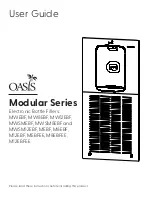
Selwood Seltorque S150 Manual
3
1. The pump unit and its associated baseplate or
trolley mounting should be positioned on a firm
horizontal platform, and in the case of portable
units restrained from accidental movement.
2. If the pump is fitted with push-on type suction and
delivery spigots the hoses must be firmly secured
on these spigots with heavy duty clamps or clips
capable of withstanding the system operating
pressure.
3. The integrity of the hose clamping arrangements
should be checked at regular daily intervals in the
case of static installations or whenever the pump
is repositioned in the case of portable units.
4. Similar precautions should be taken with clamps
securing multiple lengths of hose on installation
where long delivery and suction lines are involved.
5. Delivery hose and any associated pipework
should be capable of withstanding the maximum
system operating pressure. Suction hose should
be of the non-collapsible variety.
1. The pump should only be operated within the
speed and pressure limits detailed in the operating
handbook for the model in question.
2. If there is a danger of freezing, the fluid normally
retained within the pump between operating
cycles should be drained off through the drain taps
provided.
3. Where protective caps are used to prevent
damage to the suction and delivery spigots during
storage or in transit they must be removed before
the pump is started up.
1. Inspection and maintenance procedures are
detailed in the operating and servicing manual for
the model in question.
2. Replacement parts. Only the manufacturers or
factory approved components should be used as
replacement parts and where necessary they
should be fitted with the assistance of the special
purpose tools indicated in the operating and
servicing manual.
3. All maintenance work must be carried out with the
pump and engine/motor stationary.
1. Where I.C. engines are used to power the pump
they have been mounted in accordance with the
engine manufacturers recommendations and
adequate guarding provided between the pump
and engine.
2.
Exhaust and Exhaust Pipes.
If there is a risk of
accidental contact by operators, the exhaust
system should be lagged or screened and the
outlet directed away from operators or other
persons likely to be nearby. Direct contact with
flammable materials of all types must be avoided.
The importance of adequate ventilation to ensure
removal of exhaust fumes when engines are
operated in enclosed or covered accommodation
cannot be over-stressed. Engines should not be
run in hazardous explosive atmospheres.
3.
Access and Operation.
Ensure that the operator
can start, control and stop the engine easily by
making all controls readily accessible. Fit remote
controls if access is difficult. Follow the
instructions
laid
down
in
the
Engine
Manufacturer's Operators Handbook for starting,
operating and stopping procedures.
4.
Fuel.
In addition to the fire hazard associated with
fuel and lubricating oils, preventative action is
necessary with respect to leakage, contamination
and bodily contact.
5.
Electrical Connections.
It is essential that earth
terminals are connected with an absolutely sound
earth point and care should be taken to ensure
that the correct sized conductors are selected to
suit the current and distance to be carried.
Centaflex Couplings (Diesel
Engines)
IMPORTANT NOTES – OBSERVE STRICTLY:
The Centaflex Coupling Assembly is supplied in a pre-
assembled state and must be fitted to the pump drive
shaft and engine flywheel in this state. On no account
should any of the components that make up the
coupling assembly be dismantled unless it has become
necessary to service one of the component parts.
Typically, the most likely component to require
replacement will be the rubber element and servicing
of this item is explained in Section 1.5.3 below.
The coupling assembly consists of a central steel hub
whose outside diameter locates within a bore of a
rubber element and is secured within the element
using three cap screws that pass radially through its
outer diameter. In turn, the rubber element locates
onto three horizontal pins, equally disposed on a PCD
and each secured to the face of a steel adaptor plate
with cap screws. The cap screws securing both the
central steel hub and the horizontal pins are torque
tightened to the values shown in the table in Section
1.5.2 below.
Summary of Contents for SELTORQUE S150
Page 25: ...Selwood Seltorque S150 Manual 25 THIS PAGE INTENTIONALLY BLANK ...
Page 28: ...Selwood Seltorque S150 Manual 28 ...
Page 30: ...Selwood Seltorque S150 Manual 30 ...
Page 32: ...Selwood Seltorque S150 Manual 32 ...
Page 34: ...Selwood Seltorque S150 Manual 34 ...
Page 36: ...Selwood Seltorque S150 Manual 36 ...
Page 38: ...Selwood Seltorque S150 Manual 38 ...
Page 40: ...Selwood Seltorque S150 Manual 40 ...
Page 42: ...Selwood Seltorque S150 Manual 42 ...
Page 44: ...Selwood Seltorque S150 Manual 44 ...
Page 46: ...Selwood Seltorque S150 Manual 46 ...
Page 48: ...Selwood Seltorque S150 Manual 48 ...
Page 50: ...Selwood Seltorque S150 Manual 50 ...
Page 52: ...Selwood Seltorque S150 Manual 52 ...
Page 54: ...Selwood Seltorque S150 Manual 54 ...
Page 56: ...Selwood Seltorque S150 Manual 56 ...
Page 58: ...Selwood Seltorque S150 Manual 58 9 WIRING DIAGRAMS 9 1 Isuzu 4JG1 Engine Canopy ...
Page 60: ...Selwood Seltorque S150 Manual 60 9 3 Deutz Wiring Diagram ...
Page 62: ...Selwood Seltorque S150 Manual 62 THIS PAGE INTENTIONALLY BLANK ...




































